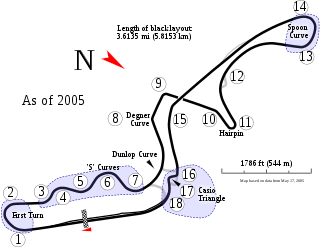
The Suzuka International Racing Course, more famously known as the Suzuka Circuit, is a 5.807 km (3.608 mi) long motorsport race track located in Ino, Suzuka City, Mie Prefecture, Japan and operated by Mobilityland Corporation, a subsidiary of Honda Motor Co, Ltd. It has a capacity of 155,000.
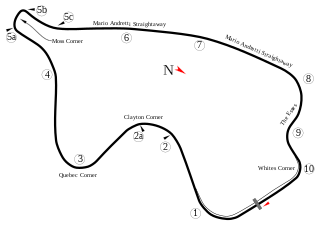
Canadian Tire Motorsport Park is a multi-track motorsport venue located north of Bowmanville, in Ontario, Canada, 64 km (40 mi) east of Toronto. The facility features a 3.957-kilometre (2.459 mi), 10-turn road course; a 2.9-kilometre (1.8 mi) advance driver and race driver training facility with a 0.40-kilometre skid pad and a 1.5-kilometre (0.93 mi) kart track. The name "Mosport", a portmanteau of Motor Sport, came from the enterprise formed to build the track.

Toyota Racing Development is the in-house tuning shop for all Toyota, Lexus and formerly Scion cars. TRD is responsible both for improving street cars for more performance and supporting Toyota's racing interests around the world. TRD produces various tuning products and accessories, including performance suspension components, superchargers, and wheels. TRD parts are available through Toyota dealers, and are also available as accessories on brand-new Toyotas and Scions. Performance parts for Lexus vehicles are now labeled as F-Sport and performance Lexus models are labeled F to distinguish Lexus's F division from TRD.

The 24 Hours of Le Mans is an endurance-focused sports car race held annually near the town of Le Mans, France. It is the world's oldest active endurance racing event. Unlike fixed-distance races whose winner is determined by minimum time, the 24 Hours of Le Mans is won by the car that covers the greatest distance in 24 hours. The cars on this track can go up to 250mph. Racing teams must balance the demands of speed with the cars' ability to run for 24 hours without mechanical failure.

The 72nd 24 Hours of Le Mans was a non-championship 24 hour automobile endurance race for Le Mans Prototype and Grand Touring cars held from 12 to 13 June at the Circuit de la Sarthe close to Le Mans, France. It was the 72nd edition of the 24 Hour race, as organised by the automotive group, the Automobile Club de l'Ouest (ACO) since 1923. A test day was held eight weeks prior to the race on 25 April. Approximately 200,000 people attended the race.

The 2002 24 Hours of Le Mans was an automobile endurance race held for Le Mans Prototype and Grand Touring cars from 15 to 16 June 2002 at the Circuit de la Sarthe, close by Le Mans, France. It was the 70th running of the event, as organized by the automotive group, the Automobile Club de l'Ouest (ACO) since 1923. A test day was held five weeks prior to the race on 5 May. The No. 1 Audi Sport Team Joest car of Tom Kristensen, Frank Biela and Emanuele Pirro won the race overall and Audi's third consecutive victory in Le Mans, extending back to the 2000 event.
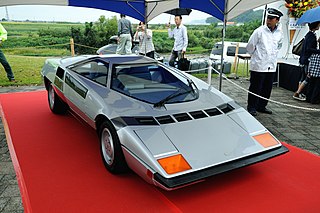
The Dome Zero was a prototype sports car from DOME Co. Ltd that was exhibited at the 48th Geneva Auto Show in 1978. The Dome project was started by Minoru Hayashi in 1975, with the goal of producing sports cars using knowledge gained from auto racing. The Zero was to be their first production road car and Dome planned to produce a limited number for sale in Japan. Despite multiple prototypes and homologation efforts, the Zero was never approved by regulatory bodies for sale in Japan or overseas. As a result, the project was not commercially viable and the Zero never entered series production.
Since its introduction to motorsport in the early 1970s, Toyota has been involved in a number of motorsport activities, most notably in Formula One, NASCAR, IndyCar, sports car racing, various off road rallies and the WRC. Currently, Toyota participates in the Toyota Racing Series, Super Formula, Formula Three, NHRA, USAC, Super GT, NASCAR, the WRC and the WEC.
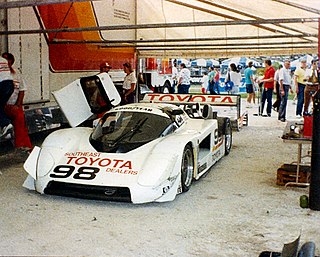
The Toyota 88C is a racing car entered by Toyota from 1988 to 1989. It is the successor to the Toyota 87C and the predecessor to the Toyota 88C-V. Like other Toyota-powered sports prototypes of the era, it was designed and built by Dome. The 88C is an evolution of the 87C, both models sharing the same chassis number designation. The 88Cs competed in the All Japan Sports Prototype Championship, the World Sports-Prototype Championship, and the North American Camel GT Championship.
Eje Elgh is a Swedish racing driver and television reporter. He currently works as an expert commentator for Formula One in Sweden together with Janne Blomqvist. The two have worked together as Formula One commentators for a long time, first for TV4 and then for Viasat Motor when they took over the Formula One broadcasting in Sweden.

The 80th 24 Hours of Le Mans was an 24-hour automobile endurance race for Le Mans Prototype and Le Mans Grand Touring Endurance cars held from 16 to 17 June 2012 at the Circuit de la Sarthe close to Le Mans, France before 240,000 spectators. It was the 80th running of the event, as organised by the automotive group, the Automobile Club de l'Ouest (ACO) since 1923. The race was the third round of the 2012 FIA World Endurance Championship, with 30 of the race's 56 entries contesting the championship. A test day was held two weeks prior to the race on 3 June.
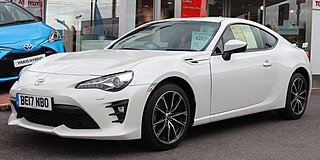
The Toyota 86 and the Subaru BRZ are 2+2 sports cars jointly developed by Toyota and Subaru, manufactured at Subaru's Gunma assembly plant.
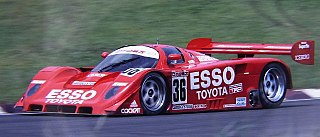
The Toyota 92C-V was a prototype racing car built by Toyota as a Group C car, and later as a LMP car. It raced in the 24 Hours of Le Mans for three years. It also took part in the final year of the All Japan Sports Prototype Championship during the 1992 season.

The 85th 24 Hours of Le Mans was a 24-hour automobile endurance event held for Le Mans Prototype (LMP) and Le Mans Grand Touring Endurance (LMGTE) cars from 17 to 18 June 2017 at the Circuit de la Sarthe, near Le Mans before 258,500 spectators. The 85th running of the race, organised by the Automobile Club de l'Ouest, was the third of nine rounds in the 2017 FIA World Endurance Championship.
The 2021 FIA World Endurance Championship was the ninth season of the FIA World Endurance Championship, an auto racing series organised by the Fédération Internationale de l'Automobile (FIA) and the Automobile Club de l'Ouest (ACO). The series is open to prototype and grand tourer-style racing cars divided into four categories. World Championship titles were awarded to the leading manufacturers and drivers in both the prototype and grand tourer divisions.
Tomiko Yoshikawa is a Japanese racing driver who competed in junior open-wheel racing and sports car categories. She entered the 24 Hours of Le Mans four times, the 24 Hours of Daytona once and also raced in her native Japan in such series as the All-Japan Formula Three Championship and the Fuji Grand Champion Series. In 1991 she was part of the first all-female LeMans driving team, driving with Lyn St. James and Desiré Wilson.

The Toyota 87C, also known as the TOM'S 87C, was a Group C prototype sports car, designed, developed and built by Toyota, for use in sports car racing, specifcally the World Sportscar Championship, between 1987 and 1988.
The Dome 86C was a racing prototype, designed, developed and built by Japanese manufacturer Toyota in partnership and collaboration with Japanese constructor Dome and homologated specifically to race in the FIA Group C category of the Fédération Internationale de l'Automobile. It was powered by a turbocharged 4T-GTE four-cylinder engine, developing between 630–670 hp (470–500 kW), depending on boost pressure. It didn't win any races, with its best result being 4th-place finish at Fuji in 1986.

The Toyota 89C-V is a Group C sports prototype racing car, developed and built by Toyota intended to participate in the World Sportscar Championship, the 24 Hours of Le Mans, and the All-Japan Japanese Sports-Prototype Championship. The chassis is designed by Japanese company Dome. It is powered by a turbocharged 3.2 L (200 cu in) Toyota R32 V8 engine, producing 800 hp (600 kW). It won 2 races, scored 4 podium finishes, and clinched 3 pole positions.

The Toyota 91C-V is a Group C sports prototype racing car, developed and built by Toyota intended to participate in the World Sportscar Championship, the 24 Hours of Le Mans, and the All-Japan Japanese Sports-Prototype Championship. It is an evolution of the previous 90C-V. Its powerplant is a turbocharged 3.2–3.6 L (200–220 cu in) Toyota V8 engine, producing 800 hp (600 kW). It won 3 races, achieved 6 podium finishes, and scored 3 pole positions. At a speed of 200 mph (320 km/h), it is capable of producing over 5,000 lbf (22,000 N) of downforce.












